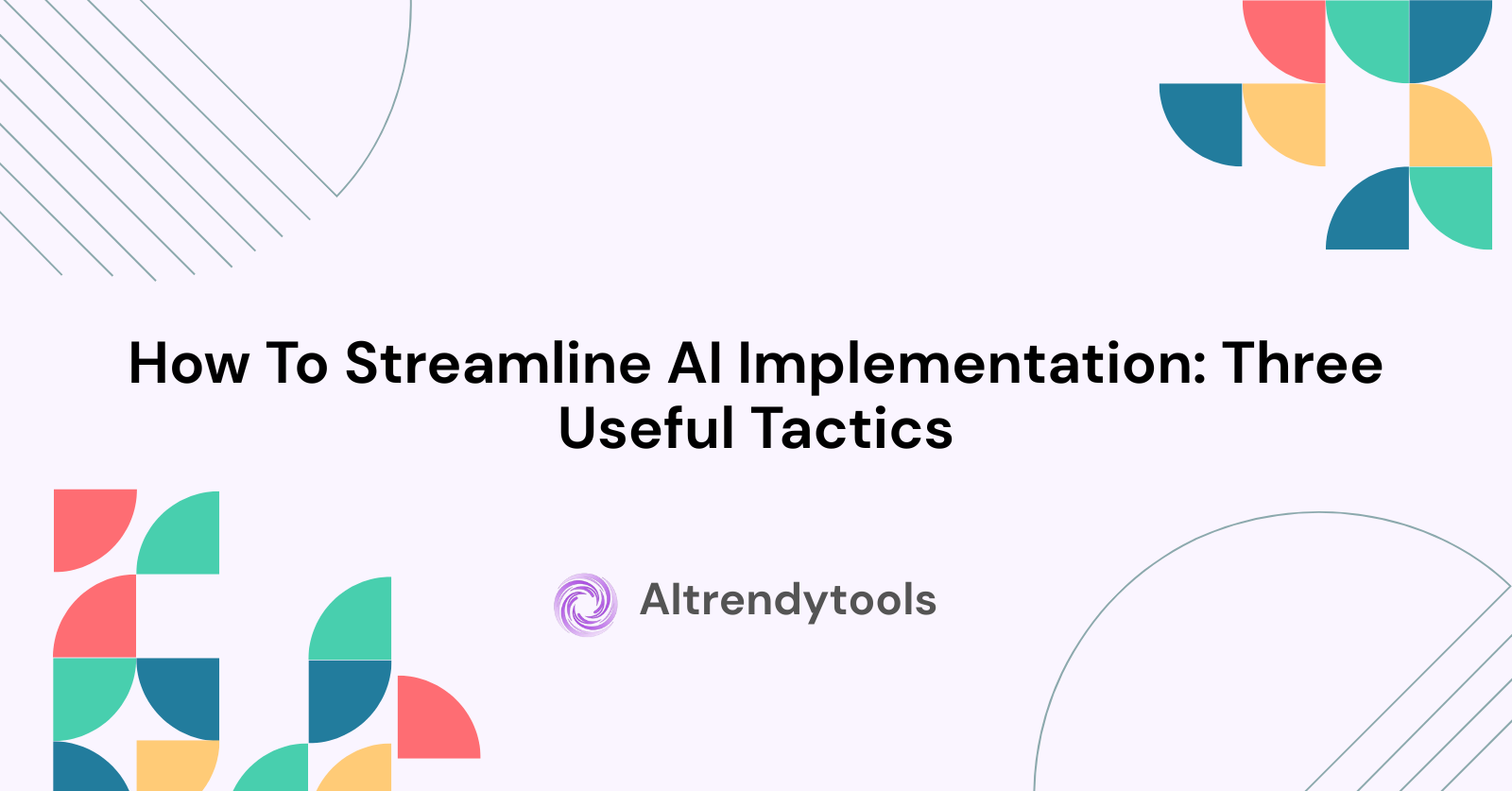🔥 AITrendytools: The Fastest-Growing AI Platform |
Write for usHow To Streamline AI Implementation: Three Useful Tactics
Learn 3 best practices for smooth AI implementation—process discovery, upskilling, and risk management—to boost efficiency and ROI.
Sep 1, 2025
As the artificial intelligence technology becomes more accessible and affordable, we are seeing an increasing number of companies implement it to streamline various business functions, from sales and marketing to finances and HR, as indicated by recent surveys. For instance, nearly 80% of respondents to McKinsey's 2025 Global Survey on AI stated they have already implemented AI at least in one business function.
Modern surveys also show that the integration of AI into work processes can provide businesses with substantial financial gains. For instance, AI can offer a potential margin increase of 10-20% and cost reduction by over 60% in the energy sector, as revealed by PwC. Also, according to the same report, AI can help increase profit margins by 40-60% in automotive, as well as generate up to $310 billion of additional profits in retail.
Being inspired by the examples of companies that already reap benefits from using AI, a lot of companies today are planning to streamline their front-office and back-office business functions with the help of AI technology. In this article, experts from Itransition, an AI consulting firm with over 5 years of experience in the field, share three best practices to help you ensure smooth AI implementation.
Determine the right processes for AI transformation
You need to begin your project by identifying processes suitable for AI transformation. However, manual process discovery is typically inefficient, especially if a company’s workflows are complex and involve many tasks. Not only is the manual approach too time-consuming and exhausting, but it can also be error-prone, which can consequently cause errors in the AI implementation planning without the proper use of AI observability.
You can ensure efficiency and accuracy of process discovery by leveraging process intelligence tools. Process mining tools, for instance, can automatically analyze log data from CRM, ERP, and other enterprise systems, outline and visualize end-to-end processes based on that analysis, and provide suggestions on which processes are ripe for improvement. Additionally, task mining tools, which are another type of process intelligence software, can track user interactions across business apps by monitoring their desktops, recognize patterns in these interactions to learn how different tasks are performed, reveal operational bottlenecks within particular processes, and highlight optimization opportunities.
Develop a robust AI upskilling strategy
Effective use of AI can require competencies and skills that your organization currently lacks, ranging from soft skills (such as fact-checking or problem-solving) to hard skills (prompt engineering, database modeling, data analytics, etc.). The lack of required skills can hinder your ability to unlock the full potential of AI-driven transformation, which can in turn reduce the technology’s ROI.
As many other business leaders, you might consider hiring properly skilled specialists the quickest and easiest way to address skill gaps within a company, but this is not always the case. After all, the number of AI-related job postings exceeds the number of specialists on the market, so finding the right talent can take many months. 54% of business executives who participated in the 2025 State of AI Report by Iconiq Capital said their companies fall behind in AI implementation mainly due to a limited pool of qualified candidates. This makes upskilling and reskilling programs to teach employees on how to work with AI a more feasible solution to close skills gaps.
Based on your business requirements, you can implement various learning methods in your AI training strategy, ranging from online courses and webinars to instructor-led training and social learning. Along with a systematized training strategy, you should also consider adopting AI tools with in-app guidance capabilities (feature tours, tooltips, etc.) to accelerate user onboarding with the new technology. 62% of respondents to the 2025 State of AI Infrastructure Report from Flexential say they run structured training programs and 63% deploy AI tools with built-in training.
Implement a tailored risk management plan
Since artificial intelligence is a transformative and disruptive technology, its implementation with expert AI consulting services can be fraught with many risks associated with AI model inaccuracy, regulatory compliance, cybersecurity, and intellectual property infringement.
Your company should proactively address relevant risks throughout AI implementation to avoid their potential negative outcomes ranging from reduced implementation ROI to complete AI project failure. The best way to do so is to develop a robust risk management plan and adhere to it continuously, from the project’s start to finish.
A risk planning process typically starts with thorough risk identification, enabling companies to understand what specific internal and external risk factors can be associated with their AI implementation projects. Interviews with project stakeholders, SWOT analysis, and causal mapping are some risk identification techniques that can come in handy during this planning stage. Then, companies should analyze and prioritize the identified risk factors to understand which ones can pose the greatest threat and should be addressed foremost with the help of a risk assessment matrix.
After prioritizing risk factors, companies should determine mitigation strategies for each risk based on their unique business requirements. Generally, there are four mitigation strategies: risk acceptance, reduction, transference, and avoidance. After determining most feasible strategies for their particular AI project and including them in risk management plans, companies should monitor risks continuously.
Final thoughts
Optimizing internal processes with the help of AI enables companies to improve their operational efficiency and employee productivity, which can contribute to their bottom lines. Whether you are planning to implement generative AI, agentic AI, or some other AI-enabled technology to streamline business processes, the recommendations provided in this article will help you succeed.
If you aim to get value from the AI technology faster and reap more significant advantages from it, you should consider hiring professional AI consultants to help with your project. Experienced consultants can help you discover processes most suitable for AI-driven optimization, suggest efficient employee training methodologies, and deliver a tailored risk management plan, which can all help you ensure smoother and more impactful AI implementation.
🚀 Submit Your Tool to Our Comprehensive AI Tools Directory
Get your AI tool featured on our complete directory at AITrendytools and reach thousands of potential users. Select the plan that best fits your needs.





Join 30,000+ Co-Founders
Related Blogs
Dext Review 2025: Guide to Automate Your Bookkeeping
Discover how Dext software transforms expense management with 99.9% accuracy. Complete guide to features, pricing, integrations & alternatives for 2025.
Texto Invisible: 10 Ways to Copy Hidden Text & Blank Space
Master texto invisible for WhatsApp, Instagram & gaming. Learn how to create hidden text, blank characters & empty spaces. Free generator + step by step guide
WriteHuman AI Review: Does It Really Bypass AI Detectors?
Honest WriteHuman AI review with real testing results. Learn if this AI humanizer actually works, pricing details, and better alternatives for 2025.
Submit Your Tool to Our Comprehensive AI Tools Directory
List your AI tool on AItrendytools and reach a growing audience of AI users and founders. Boost visibility and showcase your innovation in a curated directory of 30,000+ AI apps.





Join 30,000+ Co-Founders

